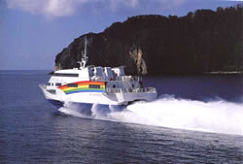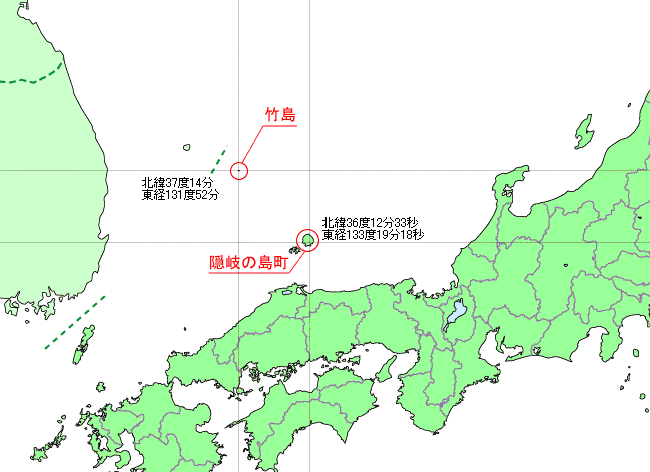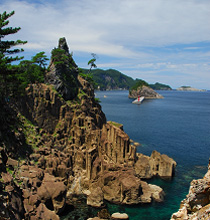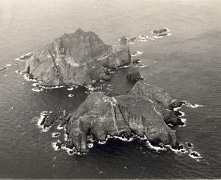Islands' location and features
Islands' location and features

Dogo Island, where the town of Okinoshima is situated, lies in the sea some 80 km northeast of the Shimane Peninsula, and is the largest island in the Oki archipelago.
Some 158 km northwest of the Oki Islands lies the island of Takeshima, which belongs to Okinoshima-cho.
Dogo Island measures 151 km around its periphery (three times Lake Shinji's periphery) and has an area of 242.
95 km2 (about 36% of Lake Biwa's area).
Some 80% of that area is covered by forest.
Dogo is a volcanic island, with a roughly circular shape. It has a chain of mountains over 500 m high, the chiefest being Mt. Daimanji, which is Oki's highest peak and 608 m high. In these mountains rise the rivers Yabigawa and Omosugawa, whose basins form a plain.
The island's entire coast is designated as part of the Daisen-Oki National Park, and with its magnificent ocean scenes and steep mountain ranges, it offers superb scenic vistas.

Climate
The climate belongs broadly to the Japan Sea coastal type, but the influence of the Tsushima Warm Current that flows in the nearby waters renders it an oceanic climate. This means a relatively small difference between summer and winter temperatures, with mild weather all year round except for midwinter.
Topology and Geology
 In geological terms the Oki Islands, though close to the Japanese mainland, belong to the Paektu Volcanic Range which extends into the Japan Sea from the Asian continent. Thus, they have the same geological formation as the islands of Ulleungdo and Takeshima, being composed principally of alkaline quartz trachyte.The Japan Sea's rough waters have eroded the islands' coastlines into numerous sheer cliffs and precipices that loom up forming superb stretches of coastal scenery.
In geological terms the Oki Islands, though close to the Japanese mainland, belong to the Paektu Volcanic Range which extends into the Japan Sea from the Asian continent. Thus, they have the same geological formation as the islands of Ulleungdo and Takeshima, being composed principally of alkaline quartz trachyte.The Japan Sea's rough waters have eroded the islands' coastlines into numerous sheer cliffs and precipices that loom up forming superb stretches of coastal scenery.
Flora and fauna
Dogo Island preserves rare natural organisms in fine condition in its pristine giant-cedar forests and warm broadleaf forests. Around the trees can be found clumps of rhododendrons unique to Oki, with beautiful pink and white blooms. Highly fragrant Aerides japonicum orchids can be seen growing naturally on the bark of the giant trees.
As for fauna, northern and southern animals live alongside each other here, although certain animals that are common on the mainland – such as the bear, deer, raccoon dog and fox – are not found, due to the environmental differences resulting from the islands' isolation. But to compensate, the islands host many species unique to Oki, including the Oki Hare, Oki Salamander and Oki Snail.
These distinctive natural ecosystems have survived thanks to the islands' remoteness.
Protecting their precious natural organisms is an important mission that has fallen to us.

Takeshima
 Takeshima belongs to the Okinoshima-cho administrative district, and is located some 158 kilometers northwest of the Oki Islands, at latitude 37° 14' north and longitude 131° 52' east. It consists of two main islands lying east and west plus several tens of boulder islets rising from reefs, amounting to a total area of 210,000 square meters – five times the size of the Tokyo Dome.
Takeshima belongs to the Okinoshima-cho administrative district, and is located some 158 kilometers northwest of the Oki Islands, at latitude 37° 14' north and longitude 131° 52' east. It consists of two main islands lying east and west plus several tens of boulder islets rising from reefs, amounting to a total area of 210,000 square meters – five times the size of the Tokyo Dome.
These islands are lacking in drinking water and are not suitable for permanent habitation by people. But the area around them forms an interface of the Tsushima Warm Current from the southward with the Liman Cold Current from the northward, so that these waters are extremely rich in both varieties and quantities of fish, shellfish and seaweeds.
In today's age of 200-nautical-mile exclusive economic zones, the waters around Takeshima can be said to have a huge value not only for our administrative district ("cho") but also for our nation, from the perspective of development of the fishery industry and assurance of fishery resources.
Takeshima has been illegally occupied by a South Korean garrison ever since 1954, creating a situation where our nation is unable to exercise its sovereignty.
In 1999, a New Agreement on Fisheries was concluded between Japan and South Korea, which declared the waters around Takeshima to be a provisional sea zone, where the exercise of fisheries by both countries was to be allowed. In actual fact however, South Korean fishing boats have monopolized these fishing grounds, overfished them, and deployed illegal fishing equipment in them, causing considerable loss to Japan's fishing industry.
In March 2005 the Shimane Prefectural Assembly enacted an ordinance for "Takeshima Day" (February 22nd every year), which has received widespread coverage in newspapers, TV and other media. Through Takeshima Day, the Takeshima problem has been slowly but steadily gaining recognition.
Okinoshima-cho will be continuing to call on the government to ensure safe fishing operations and fishing ground management in the provisional sea zone.
- このページに関するお問い合わせ
- 隠岐の島町役場 総務課 広報広聴係
TEL:08512-2-8572
FAX:08512-2-6005
MAIL:kouhou@town.okinoshima.shimane.jp



